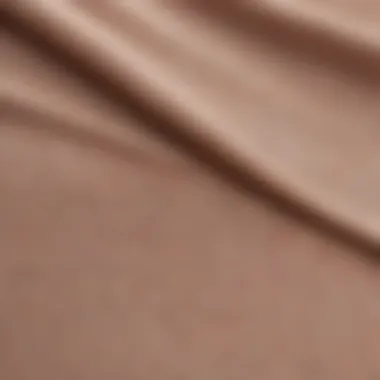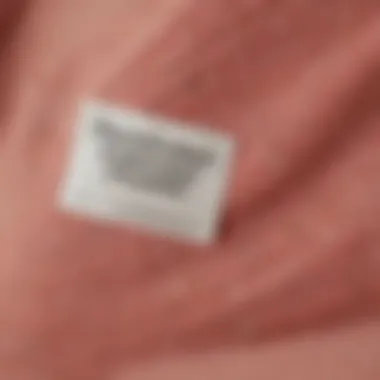Effective Strategies to Prevent Lint on Your Clothes


Intro
Lint, those little particles that cling to fabric, can be more than just a nuisance. They detract from the visual appeal of clothes and are often associated with poor garment quality. When discussing how to maintain your wardrobe's integrity, strategies to prevent lint formation gain significance. Understanding the factors that contribute to lint formation—such as fabric type, washing methods, and storage techniques—is crucial. This article provides a thoughtful analysis of practical methods to reduce lint, ranging from the selection of materials to post-wash care.
Key Factors Contributing to Lint
Before diving into the techniques, it's vital to comprehend what causes lint. Various elements interact to create this problem:
- Fabric Type: Certain textiles, like cotton and synthetic fibers, are more prone to shedding.
- Washing Practices: The way clothes are washed can amplify lint formation.
- Drying Methods: High heat settings and dryer troubles can worsen the situation.
- Storage Techniques: How garments are stored plays a notable role in lint accumulation as well.
This article seeks to identify practical, refined strategies to confront these aspects effectively.
The Significance of Fabric Selection
Choosing garments made from less lint-prone materials serves as your first line of defense. Fabrics that are tightly woven tend to attract less lint compared to those that are loosely woven. Polyester and nylon, for instance, generally shed less lint than other types. Thus, selecting the appropriate materials when adding to your wardrobe is instinctive and profound.
Best Washing Practices
Post purchase, the way you care for your clothes contributes significantly to mitigating lint issues. Here are central strategies to consider:
- Wash Similar Fabrics Together: Challenge lint movement by grouping similar fiber types.
- Use a Gentle Cycle: This reduces friction and helps preserve fabric structure.
- Avoid Overloading the Washer: This allows for sufficient water and movement, thereby reducing wear.
Also, consider cold water washing—sometimes it is beneficial—but be mindful of detergent use, as poorer quality cleansers might not wash as effectively.
Drying Essentials
Utilizing a lower heat setting during drying can preserve your clothing’s condition. Additionally, consider using dryer balls to effectively reduce lint through increased airflow and agitation. It's good sometimes to remove clothes before complete drying as it allows more control over the final outcome.
Careful Storage Practices
The last aspect — how clothing is stored — often gets overlooked. Folding clothes neatly and avoiding overcrowded storage spaces can intimate garment form integrity while preventing lint clutter. Using breathable garment bags also helps.
Efficiently warding off lint means maintaining the frame and state of your favorite clothes, allowing them to shine like a fresh splinter of silk.
This discussion elaborates on various facets concerning lint prevention whilst underpinning the significance of simplifying laundry rituals and incorporating mindful practices. The next sections will elaborately expound on reversible deductions of garment care with enhanced inspection.
Understanding Lint Formation
Understanding why lint forms on clothes is crucial for any individual who cares about maintaining the appearance of their garments. Lint can lead to unsightly marks on fabric, affecting not just their aesthetic but also perceived quality. By grasping the science behind lint, one can take proactive steps to minimize its appearance. Key factors contribute to the amount of lint generated during wear or washing, including the type of materials worn and methods of care.
What is Lint?
Lint refers to the small, loose fibers that shed from clothing materials. They accumulate on fabric surfaces and in washing machines. This phenomenon can occur with frequently worn or laundered clothes. Lint typically differs in color and texture based on the fabric from which it originates. It's essential, therefore, to understand how this matter forms and interferes with the desired cleanliness of apparel.
Common Causes of Lint Accumulation


Several factors can lead to the formation of lint. Among the most common causes are:
- Washing methods: Incorrect use of washing machines or detergents may result in excess shedding.
- Fabric friction: Raiment that rubs against each other can cause fibers to loosen.
- Wear and tear: Normal use or snagging can break down materials, causing lint production.
By addressing these elements, one can effectively minimize the associated lint contamination on clothing.
The Role of Fabric Types in Lint Production
Different fabric types contribute differently to lint production. Each material comes with its proprieties, benefits, and drawbacks.
Natural Fibers
Natural fibers like cotton and wool are common culprits for lint. They tend to shed due to their tendency to break during friction. These materials are valued for their breathability and comfort. However, they can quickly become riddled with lint if not cared for adequately. A key aspect is that, while they may produce lint, many prefer their feel against the skin.
Synthetic Fibers
Synthetic fibers such as polyester and nylon resist shedding more than natural ones. They are strong and durable, making them a practical choice within clothing lines. These fibers have a shiny appearance but may have a drawback—they can cause static, causing lint to cling tightly to the fabric. Despite this, their low-maintenance quality remains appealing to many.
Blends
Fabric blends mix natural and synthetic fibers, designed to combine the benefits of both. They might show moderate lint production, which can be advantageous for those seeking unique textile usability. The key here is that blended fabrics often perform better in terms of both durability and ease of care compared to pure materials. Lint production can be less frequent as a result of these hybrid structures.
In essence, each type of fabric has a distinct influence on lint generation and requires different care strategies. Knowing these aspects can drastically alter how clothing is maintained and kept lint-free in daily routines.
Pre-Washing Techniques
Pre-washing techniques play a pivotal role in the journey to achieving lint-free clothing. The essence of these methods lies in the nuanced understanding of how fabrics interact with each other during the wash cycle. Inadequate preparation can lead to an increased buildup of lint on garments, ultimately impacting their appearance and lifespan. By focusing on specific pre-washing strategies, one can significantly reduce lint accumulation and enhance the quality of their clothing maintenance routines.
Sorting Clothes by Fabric Type
Sorting clothes by fabric type is more than just a step in the laundry process; it's a crucial tactic in lint management. Different fabrics produce distinct types of lint. For instance, sheerer textiles can easily attract shed fibers from coarser items. Separating natural fibers from synthetic ones reduces the likelihood of lint transfer and produces cleaner results.
- Heavy versus Lightweight Fabrics: Group heavy items like towels and jeans together. Light synthetics, such as polyester blouses, should be washed separately. This approach prevents damage and minimizes lint.
- Color Consideration: While not directly related to lint, color sorting also help manage stains which, if absorbed, can render clothing dull over time.
Engagement with this initial task does require a level of diligence. However, it lays a solid foundation for an effective wash. Prioritizing this detailed sorting can pay you dividends down the line, leading to better-maintained clothes.
Using Lint Rollers Wisely
The prudent use of lint rollers can serve as an adjunct technique in your pre-wash routine. These tools effectively remove trapped dust and lint from clothing surfaces before washing. When applied correctly, lint rollers lead to a cleaner laundry process. Here are a few points to consider:
- Roll Before Washing: Apply lint rollers to garments prior to placing them in the machine. This minimizes the information created during washing.
- Utility Beyond Clothing: Don't limit your green lint-friendly practices to clothes; also use rollers on upholstery and pillows where lint builds up can often occur. By maintaining a firm grip during use, the roller can trap more lint with each pass.
- Regular Maintenance: Keep lint rollers accessible. The more often they are used, the better your clothes will appear post-wash. Simple habits now can prevent larger issues in the wash.
Adding Vinegar to the Wash Cycle
Adding vinegar in the wash cycle brings a natural cleaning power to the forefront. While many may view that vinegar merely assists with odor and stiffness, it also subtly alters lint behaviour throughout the cleansing process. Benefits of integrating vinegar into your wash include:


- Lint Removal: Vinegar helps prevent lint from adhering to fabrics, providing a barrier that protects the garments. Liquids like vinegar help dissolve grime that attracts stray particles during the wash-event.
- Static Reduction: Its anti-static properties neutralize cling, which is often found contributing to more lint forming in dryer cycles. Garments emerge smoother, ready for storage or wear without that extra fuss of leftover fabric dust.
- Non-Toxic Cleaning: Utilizing vinegar means ensuring safe and natural cleaning directly in your laundry without harsh chemicals, which could further impact your clothes.
Incorporating these techniques into your pre-wash process brings more longevity to your laundry regime. It showcases an intentionality towards everyday living that can significantly reduce frustrations with lint. Planning your wash cycle through these practical insights will lead to visibly improved results and greater satisfaction.
Washing Strategies
Washing strategies play a crucial role in preventing lint build-up on clothing. These practices help ensure that garments not only remain clean but also maintain their integrity against extraneous fiber accumulation. A thoughtful approach to washing incorporates the selection of wash settings, load size, and the choice of detergent. Addressing these areas carefully can significantly minimize lint problems, enhancing the longevity of clothes.
Selecting Appropriate Wash Settings
Choosing the right wash settings is essential in reducing lint formation. Different fabrics have distinct care requirements.
- Gentle cycles tend to cause less friction and agitation. This minimizes the potential for lint detachment.
- Cold water washing can also limit lint generation. Hot water can induce more wear and tear on fabrics, increasing lint release.
- Spin cycles should be adjusted accordingly; a high spin may draw out loose fibers but also wear fabrics faster. Moderation is key.
Familiarizing oneself with the washing machine’s manual can provide crucial guidelines on the optimal settings to apply for different fabric types. Taking the time to adjust settings ensures optimal results.
Avoiding Overloading the Washing Machine
Overloading the washing machine is one of the biggest mistakes one can make. When clothes are packed too tightly, several problems arise:
- Clothes cannot move freely, resulting in uneven washing.
- The friction between articles increases, leading to lint detaching from garments.
- Water and detergent cannot circulate efficiently, hindering cleaning.
To avoid the pitfalls of overloading, it is advised to wash smaller loads. Not only does this improve cleaning, but it also reduces furniture lint accumulation. Ensuring a balance between load capacity and garment care leads to better results.
Choosing the Right Detergent
Laundry detergents vary in formulation, and selecting an appropriate one is vital to controlling lint. Here are some factors to consider:
- Low-sudsing detergents are preferable. Unlike standard formulations, low-sudsing varieties reduce the amount of residue left behind, which can contribute to lint formation over time.
- Look for lint-reducing properties in detergents. Many brands now advertise features specifically addressing lint management.
- Always follow dosing instructions. Using too much detergent can lead to excess residue and suds, adversely impacting wash quality.
By being selective about detergent choices, you significantly contribute to minimizing lint associated with clothing. The implications of detergent choice extend beyond appearance— they can drastically improve overall fabric longevity.
Key aspect: Implementing these washing strategies should reduce visible lint and prolong the appearance of your favorite garments. A meticulously considered laundry routine leads to increasingly favorable results.
Post-Washing Care
The care you take after washing your clothes is vital for preventing lint on your garments. Neglecting the proper post-wash practice can lead to frustration, as lint becomes more both visible and itchy over time. Proper care post-washing involves two primary aspects: effective drying techniques and appropriate storage methods. These strategies ensure your clothes remain looking fresh and clean, with minimal lint accumulation after each wash.
Proper Drying Techniques
Air Drying
Air drying is a simple method that avoiderms excessive wear on fabrics. One of its key characteristics is the absence of harmful high heat and tumbling motions, which can disrupt the integrity of fibers. This gentle approach to drying clothes helps minimize static and lint production. Since there is no exposure to dryer lint, air drying can also prevent lint from transferring to your garments.
This method is increasingly popular as it is eco-friendly and energy-efficient. However, it's worth noting some disadvantages. Clothes may take longer to dry, and environmental factors such as humidity can affect the drying process. Despite this, the benefits of preserving fabric quality typically outweigh the downsides.


Using the Dryer Without Lint Filters
This approach may sound counterintuitive. Regular dryer lint filters can become clogged over time, contributing to lint accumulation on clothes. When using the dryer without a lint filter, you allow air to circulate freely throughout the dryer, which may reduce the possibility of lint trapping in the machine. A significant effect of this practice is improved airflow, leading to reduced drying times and energy consumption.
However, it's essential to stress that removing lint filters can lead to an increase in lint accumulation on your clothes. Therefore, if you choose this method, you must implement a strong, consistent lint maintenance routine. If filters are neglected or removed altogether, the dryer itself could end up producing more lint, negating the benefits of this method.
Storing Clothes Properly
After drying, how you store your clothing has a crucial impact on lint formulation over time. Proper storage reduces the chance of accumulating dust and fibers which contribute to lint. Categorizing items into drawers or boxes with limited air exposure can also help out a lot. Opt for breathable fabric bags or bins for seasonal clothing. This method prevents moisture buildup, ultimately protecting fabrics from mold, mildew, and further lint attraction.
In summary, proper post-washing care is essential for lint prevention strategies. Both air drying and judicious use of a dryer contribute to maintaining fabric quality, while thoughtful storage keeps clothes in pristine condition. Adapting these techniques into your fabric care routine allows for cleaner, fresher clothes, reducing lint's presence and prolonging the life of your garments.
Managing Lint in Daily Life
Managing lint effectively in daily life is crucial for anyone wanting to maintain their clothing in prime condition. Lint not only detracts from the appearance of garments but can also contribute to wear and tear over time. By implementing a series of manageable strategies, one can significantly diminish lint-related issues, preserving both the look and durability of clothing.
Using Fabric Shavers
Fabric shavers are practical tools designed specifically to remove lint and pilling from your clothing. They work by gently gliding over the fabric's surface, catching and collecting loose fibers. This helps restore the fabric's original look without causing damage. To ensure the fabric shaver is effective, employ it on clean garments; this will prevent dirt and stains from combining with the lint. Furthermore, take the time to read the product instructions to understand how to use it properly on different fabric types, as some materials may require gentler handling. Regular use of a fabric shaver can help optimize your clothing's appearance, making it more presentable.
Maintaining Clean Washing and Drying Appliances
Appliances involved in the washing and drying process play an essential role in lint management. Lint accumulates in the nooks and crannies of washing machines and dryers. It's vital to keep these appliances clean to ensure they release freshly laundered clothes without additional lint. Check the lint traps in your dryer regularly and clean them after every load. Moreover, consider deep cleaning your washer and dryer occasionally to remove hidden residue.
Choosing Lint-Free Fabrics for Specific Use Cases
Selecting the right fabric can help in managing lint effectively. Opt for lint-free materials such as polyester or certain tightly woven microfiber blends. These fabrics tend not to shed as much as natural fibers like cotton or wool. Furthermore, be diplomatic in choosing your linens for distinct use cases; for example, choose smoother fibers for work clothes to ensure they stay polished, while reserving softer options for more casual or home use.
Proper choice of fabric can greatly improve the lint situation.
By making informed choices about laundering, maintaining equipment, and selecting clothing fabrics wisely, it is feasible to significantly reduce lint projection in daily affairs.
Ending
In this article, we have taken a comprehensive look at the problem of lint accumulation on clothing and the various strategies for preventing it. Understanding the origins and causes of lint is key. These key points help you develop effective practices during washing, drying, and storing your garments.
Recap of Effective Strategies
Here are the main strategies discussed:
- Pre-Washing Techniques: Sorting clothes by fabric type and using lint rollers can significantly reduce lint presence before garments even go through the wash. Additionally, adding vinegar can assist in loosening lint from fibers.
- Washing Strategies: Selecting appropriate wash settings and avoiding overloading your washing machine are vital. This ensures an even distribution of garments and minimizes friction that contributes to lint production. Choosing the right detergent with specific properties can also optimize wash performance and reduce lint debris.
- Post-Washing Care: Utilizing proper drying techniques is important. Both air drying and using the dryer correctly make a difference in producing less lint. Furthermore, storing clothes properly minimizes any lint accumulation over time.
- Managing Lint in Daily Life: Maintenance activities such as using fabric shavers, keeping washing machines and dryers clean, and being mindful of fabric selection when buying new clothes contribute greatly towards lessening lint.
Adopting these strategies will result in noticeable improvements in your clothing’s cleanliness and appearance.
Encouragement for Consistent Maintenance
Consistency is the cornerstone of ensuring long-term results against lint accumulation. It’s not merely about implementing these strategies once; it is about incorporating them as part of your regular clothing care routine. This involves:
- Routine Checks: Every time you wash or dry clothing, take a moment to refine your approach and make adjustments as necessary.
- Continued Education: Stay informed about fabric care, as properties of textiles can change over time.
- Proper Equipment Maintenance: Regularly service and clean washing and drying machines to ensure they operate efficiently, averting lint hotspots.
Maintaining diligence towards these practices confirms that fresh, lint-free clothes can remain a standard embellishment in your wardrobe. Small changes lead to significant results over time, preserving the integrity of your textiles.
In summary, a strong and effective clothing care regimen, with an emphasis on consistent maintenance, lays the groundwork for an effortlessly lint-free lifestyle.







